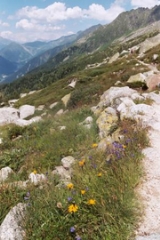
Alpine plant
Encyclopedia
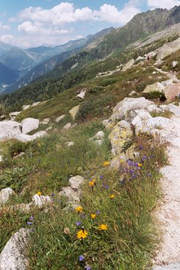
Alpine climate
Alpine climate is the average weather for a region above the tree line. This climate is also referred to as mountain climate or highland climate....
, which occurs at high elevation
Elevation
The elevation of a geographic location is its height above a fixed reference point, most commonly a reference geoid, a mathematical model of the Earth's sea level as an equipotential gravitational surface ....
and above the tree line. Alpine plants grow together as a plant community in alpine tundra
Alpine tundra
Alpine tundra is a natural region that does not contain trees because it is at high altitude. Alpine tundra is distinguished from arctic tundra, because alpine soils are generally better drained than arctic soils...
.
Alpine plant diversity
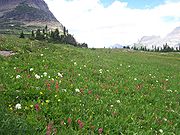
Taxonomy
Taxonomy is the science of identifying and naming species, and arranging them into a classification. The field of taxonomy, sometimes referred to as "biological taxonomy", revolves around the description and use of taxonomic units, known as taxa...
diversity can be attributed to geographical isolation, climate change
Climate change
Climate change is a significant and lasting change in the statistical distribution of weather patterns over periods ranging from decades to millions of years. It may be a change in average weather conditions or the distribution of events around that average...
s, glaciation
Glacial period
A glacial period is an interval of time within an ice age that is marked by colder temperatures and glacier advances. Interglacials, on the other hand, are periods of warmer climate within an ice age...
, microhabitat differentiation, and different histories of migration
Seed dispersal
Seed dispersal is the movement or transport of seeds away from the parent plant. Plants have limited mobility and consequently rely upon a variety of dispersal vectors to transport their propagules, including both abiotic and biotic vectors. Seeds can be dispersed away from the parent plant...
or evolution
Evolution
Evolution is any change across successive generations in the heritable characteristics of biological populations. Evolutionary processes give rise to diversity at every level of biological organisation, including species, individual organisms and molecules such as DNA and proteins.Life on Earth...
or both. These phenomena contribute to plant diversity by introducing new flora and favoring adaptations, both of new species and the dispersal of pre-existing species. Common plant life-form
Plant life-form
Plant life-form schemes constitute a way of classifying plants alternatively to the ordinary species-genus-family scientific classification. In colloquial speech, plants may be classified as trees, shrubs, herbs , etc...
s include prostrate shrub
Prostrate shrub
A prostrate shrub is a woody plant, most of the branches of which lie upon or just under the ground, rather than being held erect as are the branches of most trees and shrubs....
s, graminoids
Grass
Grasses, or more technically graminoids, are monocotyledonous, usually herbaceous plants with narrow leaves growing from the base. They include the "true grasses", of the Poaceae family, as well as the sedges and the rushes . The true grasses include cereals, bamboo and the grasses of lawns ...
forming a tussock
Tussock (grass)
Tussock grasses or bunch grasses are found as native plants in natural ecosystems, as forage in pastures, and as ornamental grasses in gardens....
, herbaceous perennial plants, cushion plants, and cryptogams
Cryptogams
The name cryptogams is used fairly widely as a phrase of convenience, although regarded as an obsolete taxonomic term. A cryptogam is a plant that reproduces by spores...
, such as bryophytes and lichens.
Surviving low temperature extremes
Most alpine plants are faced with low temperature extremes at some point in their lives. There are a number of ways that a plant can survive these extremes. Plants can avoid exposure to low temperature by using different forms of seasonal phenologyPhenology
Phenology is the study of periodic plant and animal life cycle events and how these are influenced by seasonal and interannual variations in climate...
, morphology
Morphology (biology)
In biology, morphology is a branch of bioscience dealing with the study of the form and structure of organisms and their specific structural features....
, or by variable growth form preference. They can also avoid the freezing of their exposed tissues
Tissue (biology)
Tissue is a cellular organizational level intermediate between cells and a complete organism. A tissue is an ensemble of cells, not necessarily identical, but from the same origin, that together carry out a specific function. These are called tissues because of their identical functioning...
by increasing the amount of solutes in their tissues, known as freezing-point depression
Freezing-point depression
Freezing-point depression describes the phenomenon in which the freezing point of a liquid is depressed when another compound is added, meaning that a solution has a lower freezing point than a pure solvent. This happens whenever a non-volatile solute is added to a pure solvent, such as water...
. Another, somewhat similar, method plants may use to avoid freezing is supercooling
Supercooling
Supercooling, also known as undercooling, is the process of lowering the temperature of a liquid or a gas below its freezing point without it becoming a solid....
, which prevents ice
Ice
Ice is water frozen into the solid state. Usually ice is the phase known as ice Ih, which is the most abundant of the varying solid phases on the Earth's surface. It can appear transparent or opaque bluish-white color, depending on the presence of impurities or air inclusions...
crystallization within plant tissues. These methods are only sufficient when temperature is only moderately cold. In the alpine zone
Alpine tundra
Alpine tundra is a natural region that does not contain trees because it is at high altitude. Alpine tundra is distinguished from arctic tundra, because alpine soils are generally better drained than arctic soils...
, temperatures are often low enough that these methods are not sufficient. When plants need a more permanent solution, they can develop freeze tolerance. Plants can also dehydrate
Dehydration
In physiology and medicine, dehydration is defined as the excessive loss of body fluid. It is literally the removal of water from an object; however, in physiological terms, it entails a deficiency of fluid within an organism...
their cells by moving water
Water
Water is a chemical substance with the chemical formula H2O. A water molecule contains one oxygen and two hydrogen atoms connected by covalent bonds. Water is a liquid at ambient conditions, but it often co-exists on Earth with its solid state, ice, and gaseous state . Water also exists in a...
into intercellular spaces
Extracellular matrix
In biology, the extracellular matrix is the extracellular part of animal tissue that usually provides structural support to the animal cells in addition to performing various other important functions. The extracellular matrix is the defining feature of connective tissue in animals.Extracellular...
. This causes ice formation outside of the cell
Cell (biology)
The cell is the basic structural and functional unit of all known living organisms. It is the smallest unit of life that is classified as a living thing, and is often called the building block of life. The Alberts text discusses how the "cellular building blocks" move to shape developing embryos....
where ice crystals
Ice crystals
Ice crystals are a small crystalline form of ice including hexagonal columns, hexagonal plates, dendritic crystals, and diamond dust. The highly symmetric shapes are due to depositional growth, namely, direct deposition of water vapour onto the ice crystal...
will not cause damage.When all of these strategies fail to prevent frost
Frost
Frost is the solid deposition of water vapor from saturated air. It is formed when solid surfaces are cooled to below the dew point of the adjacent air as well as below the freezing point of water. Frost crystals' size differ depending on time and water vapour available. Frost is also usually...
damage, alpine plants often have the capacity to repair or replace the organs
Organ (anatomy)
In biology, an organ is a collection of tissues joined in structural unit to serve a common function. Usually there is a main tissue and sporadic tissues . The main tissue is the one that is unique for the specific organ. For example, main tissue in the heart is the myocardium, while sporadic are...
damaged. As it is often difficult to prevent damage, many alpine plants depend on the replacement of their organs. They help make this possible by placing their meristems below ground, where temperatures are generally warmer.
Avoidance of desiccation
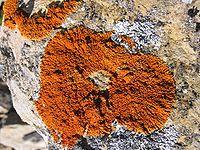
Vascular plant
Vascular plants are those plants that have lignified tissues for conducting water, minerals, and photosynthetic products through the plant. Vascular plants include the clubmosses, Equisetum, ferns, gymnosperms and angiosperms...
, tissue desiccation is rare at high altitudes. If it does occur, it normally happens to plants growing on exposed sites, where wind
Wind
Wind is the flow of gases on a large scale. On Earth, wind consists of the bulk movement of air. In outer space, solar wind is the movement of gases or charged particles from the sun through space, while planetary wind is the outgassing of light chemical elements from a planet's atmosphere into space...
stress is increased. Alpine plants avoid water loss by deep rooting
Root
In vascular plants, the root is the organ of a plant that typically lies below the surface of the soil. This is not always the case, however, since a root can also be aerial or aerating . Furthermore, a stem normally occurring below ground is not exceptional either...
and increased stomatal
Stoma
In botany, a stoma is a pore, found in the leaf and stem epidermis that is used forgas exchange. The pore is bordered by a pair of specialized parenchyma cells known as guard cells that are responsible for regulating the size of the opening...
control. Plants at low elevation normally reach maximum stomatal opening in the morning while alpine plants reach maximum opening mid-day, when temperature is greatest. Alpine succulent plants often utilize CAM photosynthesis
Crassulacean acid metabolism
Crassulacean acid metabolism, also known as CAM photosynthesis, is a carbon fixation pathway that evolved in some plants as an adaptation to arid conditions. The stomata in the leaves remain shut during the day to reduce evapotranspiration, but open at night to collect carbon dioxide...
to avoid water loss.
Avoidance of ultraviolet radiation
Because ultravioletUltraviolet
Ultraviolet light is electromagnetic radiation with a wavelength shorter than that of visible light, but longer than X-rays, in the range 10 nm to 400 nm, and energies from 3 eV to 124 eV...
radiation tends to increase with elevation, it is often assumed to be a stress factor among alpine plants. In the past, there have been many attempts to research how ultraviolet radiation may influence alpine plant forms. However, it is uncertain if the growth and development of plants is affected by ultraviolet radiation. It is also not clear if the radiation is responsible for promoting genetic differentiation, leading to stunted growth forms.
Reproduction
Alpine plants use both sexual reproductionSexual reproduction
Sexual reproduction is the creation of a new organism by combining the genetic material of two organisms. There are two main processes during sexual reproduction; they are: meiosis, involving the halving of the number of chromosomes; and fertilization, involving the fusion of two gametes and the...
and asexual reproduction
Asexual reproduction
Asexual reproduction is a mode of reproduction by which offspring arise from a single parent, and inherit the genes of that parent only, it is reproduction which does not involve meiosis, ploidy reduction, or fertilization. A more stringent definition is agamogenesis which is reproduction without...
. Sexual reproduction has limits in high alpine areas, especially in areas with a short growing season
Growing season
In botany, horticulture, and agriculture the growing season is the period of each year when native plants and ornamental plants grow; and when crops can be grown....
in alpine zones at high latitudes. In tropical alpine zones with a year round growing season, such as the northern Andes
Andes
The Andes is the world's longest continental mountain range. It is a continual range of highlands along the western coast of South America. This range is about long, about to wide , and of an average height of about .Along its length, the Andes is split into several ranges, which are separated...
, plants can flower year round. Regardless of when alpine plants flower, pollinators are often scarce. The activity of pollinators decreases with increasing altitude. The most common pollinators in the alpine zone are bumblebees and flies
Fly
True flies are insects of the order Diptera . They possess a pair of wings on the mesothorax and a pair of halteres, derived from the hind wings, on the metathorax...
. Plants utilize different strategies to deal with these limits, including alternate flowering time and clonal propagation.
Early flowering plants
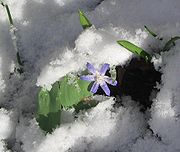
Inflorescence
An inflorescence is a group or cluster of flowers arranged on a stem that is composed of a main branch or a complicated arrangement of branches. Strictly, it is the part of the shoot of seed plants where flowers are formed and which is accordingly modified...
. In order to minimize frost damage, preformed flowers are often surrounded by tightly packed bracts that are densely covered in trichomes. This helps to keep the interior of a flower bud
Bud
In botany, a bud is an undeveloped or embryonic shoot and normally occurs in the axil of a leaf or at the tip of the stem. Once formed, a bud may remain for some time in a dormant condition, or it may form a shoot immediately. Buds may be specialized to develop flowers or short shoots, or may have...
warm. Because of early season pollinator limitation, plants that bloom early generally have a low rate of reproductive success. One advantage of flowering early is that seeds that are produced have a greater chance of developing to maturity before the next freeze. They also have a high outcrossing
Outcrossing
Outcrossing is the practice of introducing unrelated genetic material into a breeding line. It increases genetic diversity, thus reducing the probability of all individuals being subject to disease or reducing genetic abnormalities...
rate, which helps to increase genetic diversity
Genetic diversity
Genetic diversity, the level of biodiversity, refers to the total number of genetic characteristics in the genetic makeup of a species. It is distinguished from genetic variability, which describes the tendency of genetic characteristics to vary....
.
Mid-season flowering
Approximately half of all alpine species flower in mid-season. Flowering at the seasonal peak combines some of the advantages and risks of early flowering and late flowering plants. Some mid-season plants pre-form of their inflorescences but not all do.Late flowering
Late flowering occurs after the main growing season ends. They have a high seed output but their seeds have a reduced rate of maturing because of time constraints. These plants tend towards self pollination, apomixisApomixis
In botany, apomixis was defined by Winkler as replacement of the normal sexual reproduction by asexual reproduction, without fertilization. This definition notably does not mention meiosis...
, and vivipary
Vivipary
Vivipary has two different meanings. In animals, it means development of the embryo inside the body of the mother, eventually leading to live birth, as opposed to laying eggs...
.
Clonal progagation
Because investment in flowers and seed production can be costly for alpine plants, they often use clonal propagationVegetative reproduction
Vegetative reproduction is a form of asexual reproduction in plants. It is a process by which new individuals arise without production of seeds or spores...
. This strategy becomes increasingly more frequent as altitude increases, and is most common among cryptogams
Cryptogams
The name cryptogams is used fairly widely as a phrase of convenience, although regarded as an obsolete taxonomic term. A cryptogam is a plant that reproduces by spores...
and grasses. Some alpine plants use it as their predominant method of reproduction. In these plants, sexual reproduction is rare and does not contribute significantly to reproductive output. An example of such a plant is Carex
Carex
Carex is a genus of plants in the family Cyperaceae, commonly known as sedges. Other members of the Cyperaceae family are also called sedges, however those of genus Carex may be called "true" sedges, and it is the most species-rich genus in the family. The study of Carex is known as...
curvula, which is estimated to have a clonal age of approximately 2000 years.
Medicinal alpine plants
There are a number of alpine plants that are used economicallyEconomics
Economics is the social science that analyzes the production, distribution, and consumption of goods and services. The term economics comes from the Ancient Greek from + , hence "rules of the house"...
. In the Himalayas
Himalayas
The Himalaya Range or Himalaya Mountains Sanskrit: Devanagari: हिमालय, literally "abode of snow"), usually called the Himalayas or Himalaya for short, is a mountain range in Asia, separating the Indian subcontinent from the Tibetan Plateau...
, hundreds of species are traded for medicinal and aromatic uses. It is estimated that the annual trade of these plants amounts to millions of US dollars. Many households in rural Nepal
Nepal
Nepal , officially the Federal Democratic Republic of Nepal, is a landlocked sovereign state located in South Asia. It is located in the Himalayas and bordered to the north by the People's Republic of China, and to the south, east, and west by the Republic of India...
rely on medicinal
Medicine
Medicine is the science and art of healing. It encompasses a variety of health care practices evolved to maintain and restore health by the prevention and treatment of illness....
alpine plant trade as a source of income. This creates an increased need to focus on plant conservation
Conservation biology
Conservation biology is the scientific study of the nature and status of Earth's biodiversity with the aim of protecting species, their habitats, and ecosystems from excessive rates of extinction...
in these areas, ensuring sustainable harvest
Sustainable yield
The sustainable yield of natural capital is the ecological yield that can be extracted without reducing the base of capital itself, i.e. the surplus required to maintain ecosystem services at the same or increasing level over time. This yield usually varies over time with the needs of the...
as well as ecosystem
Ecosystem
An ecosystem is a biological environment consisting of all the organisms living in a particular area, as well as all the nonliving , physical components of the environment with which the organisms interact, such as air, soil, water and sunlight....
sustainability. Some of the species harvested in Nepal include Neopicrorhiza scrophulariiflora, Nardostachys grandiflora
Spikenard
Spikenard is a flowering plant of the Valerian family that grows in the Himalayas of China, also found growing in the northern region of India and Nepal. The plant grows to about 1 m in height and has pink, bell-shaped flowers...
, Shilajit
Shilajit
Shilajit, also known as silajit, mumijo, and momia, is a thick, sticky tar-like substance with a colour ranging from white to dark brown , sometimes found in Caucasus mountains, Altai mountains and Tibet mountains....
, Aconitum
Aconitum
Aconitum , known as aconite, monkshood, wolfsbane, leopard's bane, women's bane, Devil's helmet or blue rocket, is a genus of over 250 species of flowering plants belonging to the buttercup family .-Overview:These herbaceous perennial plants are chiefly natives of the mountainous parts of the...
spicatum, Dioscorea
Dioscorea
Dioscorea is a genus of over 600 species of flowering plants in the family Dioscoreaceae, native throughout the tropical and warm temperate regions of the world. The vast majority of the species are tropical, with only a few species extending into temperate climates...
deltoidea, Aconitum heterophyllum, Rheum australe. Bergenia
Bergenia
Bergenia is a genus of ten species of flowering plants in the family Saxifragaceae, native to central Asia, from Afghanistan to China and the Himalayan region...
, and Epimerantha macraei.

